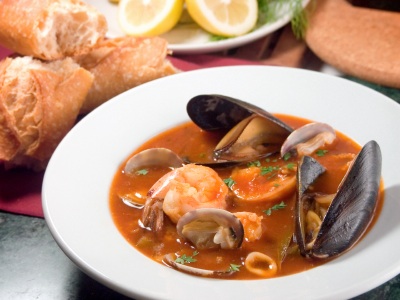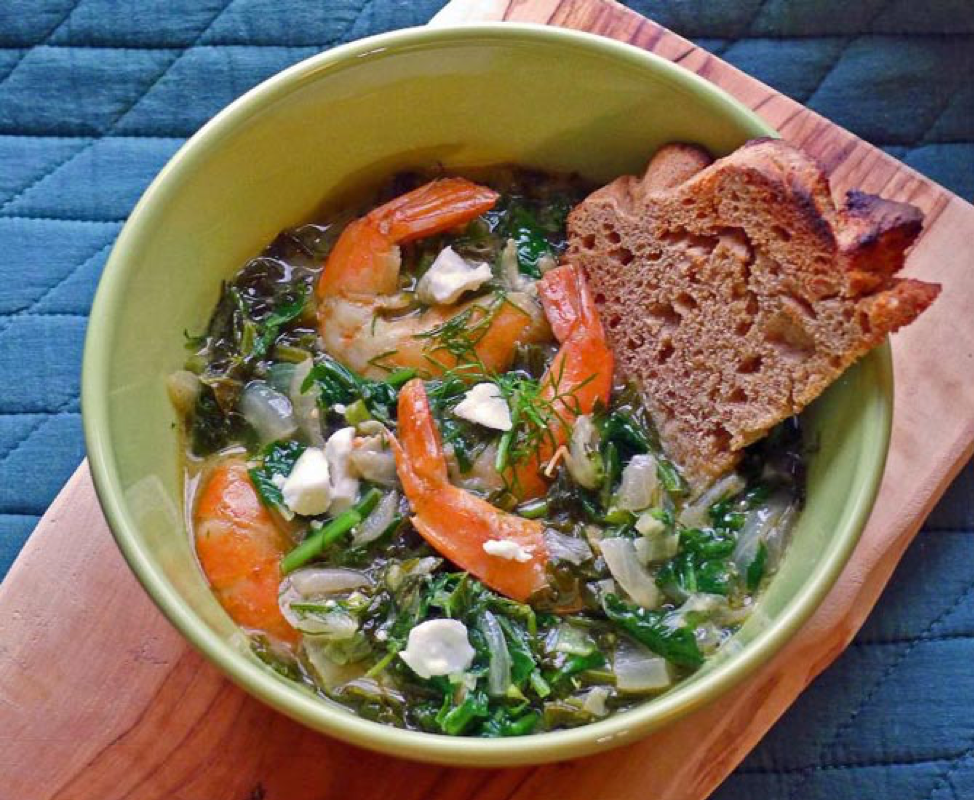Nearly two dozen countries border the Mediterranean Sea, so it’s not surprising that fish and seafood feature prominently in the Mediterranean diet. Nearly every coastal Mediterranean region has its own version of seafood stew. While variations of seafood stew have evolved over time, many originated from humble beginnings, that is, as a means of utilizing less desirable types of fish (i.e., fish that were too bony or too small to be prepared in other ways).
Bouillabaisse, from the southern French port city of Marseille, is a spicy fish stew. Originally, bouillabaisse was a frugal fisherman’s stew of leftovers (i.e., bones, heads, and tails from the day’s catch and fish too small to sell). Over time, variations of bouillabaisse have been created, though traditionally a bouillabaisse includes the rascasse fish, also referred to as the scorpion fish. However, in the US, not all traditional fish are available, and the recipe is at the discretion of the chef. In addition to an assortment of fish, bouillabaisse can include potatoes, onions, fennel, saffron, orange zest, wild herbs, and/or local wine. Bouillabaisse is typically served with garlic-infused croutons and rouille (ROO-ee), a traditional Provençal sauce made from garlic, breadcrumbs, and olive oil that has a similar consistency to aioli, a garlicky mayonnaise.
Bourride, bouillabaissse‘s lesser known cousin, comes from the from Provencal boulido meaning “boiled.” It’s typically less fussy than bouillabaise, served along the Languedoc coast from Saint-Raphaël to Nice.
Brodetto, from brodo meaning broth, is a seafood stew that originated from the Marche region of Italy, between Emilia Romagna and the Abruzzi. Similar to bouillabaisse, brodetto was customarily made from the leftovers and unwanted scraps that couldn’t be sold at the market, including the scorpion fish (scorfano in Italian). According to historical accounts, in Marche, a classic brodetto contains 13 types of seafood, the number thirteen representing the 13 guests of the Last Supper. Tomatoes, olive oil, and wine round out this stew.
Brodet is Croatia’s version of brodetto and is made with at least three different kinds of thick, meaty fish, such as scorpion, rockfish, and perch. Shellfish (e.g., scampi, mussels, crabs) and conger eel can also find their way into brodet. Brodet is often served with polenta, which acts as a sponge to soak up the flavorful broth.
Cacciucco is an Italian fish stew native to the western coastal towns of Tuscany and Liguria. Traditionally, no fewer than five types of fish go into cacciucco, reportedly, one type of fish for every ‘c’ in its name. Anything from fish (e.g., red mullet, sole, monkfish, sea bass) to seafood (e.g., cuttlefish, octopus, prawns, mussels, squid, and scallops) is fair game for cacciucco.
Chreime is a spicy Tunisian fish stew of Sephardic-Jewish origin. Traditionally, inexpensive cuts of fish (firm white fish cut into steaks) were used. The fish steaks are braised in a thick, spicy tomato-based sauce spiced with plenty of paprika, cumin, and caraway seeds.
Kakavia is a classic Greek fisherman’s stew and is considered to be the precursor to bouillabaisse, making its way from Greece to Marseille around 600 B.C. and evolving into modern-day bouillabaisse. Kakavia is named for the cooking vessel, known as a kakavi, in which it is prepared. Like other seafood stews from the Mediterranean, there are many variations. The type of fish/seafood varies depending on the day’s catch, often rockfish or petropsara, especially scorpion fish, along with small, bony fish such as perch and mullet, which makes for a thick, gelatinous, hearty stew. Vegetables such as potatoes, onions, and celery are cooked in plenty of olive oil before the fish is added.
Zarzuela de mariscos is a seafood stew from the Catalan coast of northeast Spain. The main ingredient is, not surprisingly, seafood, anything from fish, mussels, clams, and shrimp to calamari, along with potatoes and tomatoes. Its foundation also includes a picada, a traditional Catalan sauce made from roasted and ground almonds, fried bread, garlic, and chile. The aforementioned ingredients are crushed into a dense paste, resulting in a thick, hearty sublime stew with pronounced depth of flavor.
Want biweekly Med Diet information and recipes in your Inbox? Sign up for our Fresh Fridays newsletter by clicking the Subscribe button at the bottom of this page!
Join the Make Every Day Mediterranean Club Facebook group for additional information and support.








